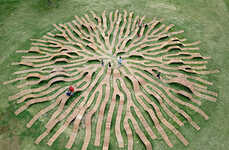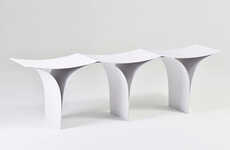
The 'Logan' Bench is Inspired by Many Aspects of Japanese Design
Michael Hemsworth — October 10, 2018 — Art & Design
References: yankodesign
The 'Logan' bench is a tradition-honoring piece of furniture that has been designed by Shwetha Iyengar, Srishti Singh and Aakanksha Gupta to pay homage to several different disciplines.
The rocking bench is inspired by the work of George Nakashima, calligraphy, Japanese architecture and even the design principles of balance, ensue and asymmetry. These inspirations work together to create a functional furniture solution that is strategically simple yet highly functional to make it suitable for placement in modern living or working spaces without looking out of place.
The 'Logan' bench is sized to be the perfect spot for two to sit and for them to work together to create a soothing rocking motion when moving in tandem for a touch of charm.
The rocking bench is inspired by the work of George Nakashima, calligraphy, Japanese architecture and even the design principles of balance, ensue and asymmetry. These inspirations work together to create a functional furniture solution that is strategically simple yet highly functional to make it suitable for placement in modern living or working spaces without looking out of place.
The 'Logan' bench is sized to be the perfect spot for two to sit and for them to work together to create a soothing rocking motion when moving in tandem for a touch of charm.
Trend Themes
1. Japanese Design - Exploring Japanese design principles can lead to innovative and culturally-inspired furniture solutions.
2. Functional Simplicity - Creating furniture solutions that are strategically simple yet highly functional can appeal to modern living and working spaces.
3. Collaborative Seating - Designing furniture that facilitates collaboration and interaction between two people can enhance the user experience.
Industry Implications
1. Furniture - Incorporating Japanese design principles into furniture can disrupt the industry and appeal to a culturally-inspired market.
2. Architecture - Applying Japanese architectural principles to furniture design can create innovative and visually appealing seating solutions.
3. Interior Design - Integrating functional simplicity and collaborative seating into interior spaces can enhance the overall design and user experience.
4.4
Score
Popularity
Activity
Freshness























